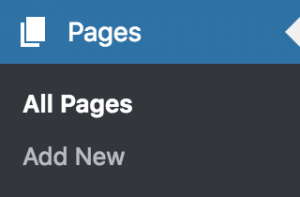Page Creation Process
The process of creating, editing, and deleting a page is the same for all Interior Pages.
An Interior Page refers broadly to any page on your site that is not the Front Page.
Creating a Page
To add a new page, hover your cursor over the “Pages” tab in the left-hand navigation menu on the dashboard and, in the fly-out menu, click Add New.

Alternatively, you can click on the “Pages” menu option and then select either “Add New” underneath or at the top of the page.
This will take you to a blank page editor that may be edited using any of the components below.
Titles
You can enter a title for your page into the topmost field of the editor that reads “Add title”.

This title will be displayed as an H1 header at the top of the page in question. If the field is left blank, no title will be displayed.

Once you enter a title, a permalink for the page will automatically be generated below. This is the URL at which your page will be available once it is published. You can change this URL at any time by clicking the “Edit” button next to it.

Clicking this permalink will bring you to the page on the live site, or to a preview of the page if it has not yet been published.
Visual Editor
The majority of a page’s content is configured using the WYSIWYG (What You See Is What You Get) text editor. You can add formatted text, links, media, and much more to a page using this editor with no coding knowledge whatsoever.
Any content you add to the WYSIWYG editor will, for the most part, appear on your live site in the exact same way it appears in the editor.


Check out the Full-Width Text Editor Module documentation for more information about the WYSIWYG editor.
Flexible Content Builder Modules
You can add a variety of pre-formatted content to the body of your page using the Flexible Content Builder modules below the main WYSIWYG editor.

Check the Flexible Content Builder modules section of the documentation for more information on how to use these layout tools.
Page Modules
Page Modules are areas of the page editor that provide additional page customization features.
Depending on which Screen Options you’ve enabled, the modules displayed and their exact placement on the page editor will differ, but there are four main modules involved in the creation of a page: Publish, Page Attributes, Sidebar Position and Sidebar.
The Sidebar and Sidebar Position modules have to do with configuring your page’s sidebar. More information about these modules is available on the Sidebars & Footer Columns documentation page.
The Publish module allows you to publish or draft a page, configure its level of visibility, and access revisions.


To publish your page, simply click the “Publish” button in the Publish module.
The Page Attributes module allows you to assign the page a Parent, specialized templates, and a numerical order on your site.

Editing a Page
The process of editing a page is very similar to that of creating a page.
You can edit a page by finding it on the All Pages view, and clicking on Edit. This will take you to that page’s editor.

You can then add, remove, or edit existing content as before using the visual editor, content builder modules, and page modules.
To access past versions of a page when editing, check out the Revisions Timeline.
Deleting a Page
You can delete a page by hovering over it in the All Pages view and clicking on Trash.

Alternatively, you can delete the page you’re currently editing by clicking Move to Trash at the bottom of the Publish module.

Keep in mind that you will not receive a prompt to confirm deletion before trashing a page.
Deleted pages are automatically sent to the Trash, which you can find at the top of the All Pages view.

The Trash is a listing of all deleted pages on your site.

From here, you can choose to either permanently delete the page, or to restore it to its former status. This fail-safe prevents any pages from being accidentally deleted for good.
